#but i expected getting 30-ish answers and being able to post the results pretty quickly
Explore tagged Tumblr posts
Text
For the survey I originally said it would take a few days after the survey closes to post the results, but with how many answers we’ve gotten it is probably gonna take a week, maybe two to do it instead. Apologies for the inconvience.
Also, if anyone wants to be tagged/notified when it comes out, send me an ask and I’ll add you to the taglist!
#the duck quacks#tazsurvey2023#apologies again that its gonna take a bit longer#but i expected getting 30-ish answers and being able to post the results pretty quickly#not 129 answers gjdflsgjf (especially since im trying to add the open questions to the results too)
2 notes
·
View notes
Text
Aether Revolt Commander Set Review
For each new set, I write an article discussing the new legendary creatures and the nonlegendary cards that I think will be relevant in Commander.
The Set Overall
I think Aether Revolt is a great set for Commander. Most of the legends are playable (and a few are quite powerful), there are a lot of cards for niche archetypes, and the artifact decks got a ton of support. Considering that Standard sets are not designed with Commander in mind, I think we made out like bandits.
Also, Paradox Engine is the most broken card to see print in the last few years.
The Commanders
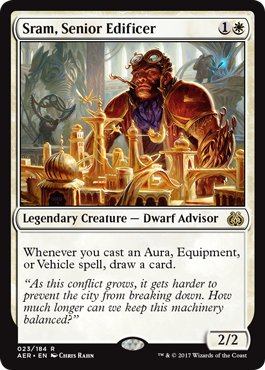
He may seem like he’s just a value commander, but the best version of Sram is probably the Equipment combo deck. There are so many 0-1 CMC equipment (like, more than 50) that it’s not particularly difficult to cast a dozen or more of them in a turn (it helps if you’ve got cost reduction effects and some additional card draw). Once you’ve dumped a few dozen equipment onto the field, you can just slap them onto Sram (with a little help on the equip costs from Puresteel or Sigarda) and swing for a ton of Commander damage. Here’s the list I’ve been playing with:
Sram Equipment Combo
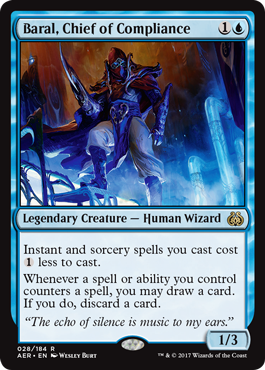
Baral is quite good in Azami and Talrand, but I think he’s even better in the command zone. My first take on Baral was a pretty passive draw-go list, but a clever reader suggested High Tide combo and the resulting deck I made is pretty damn solid. Baral can save you a dozen or more mana over the course of a High Tide turn, greatly improving your odds of comboing off. Here’s the list I’ve been playing with:
Baral High Tide Combo

Haste and the ability to protect one’s self are key qualifications for a strong Voltron commander (a low CMC is another), so Yahenni fits neatly into that archetype. In addition, their sacrifice ability gives you much more room to build around them than similar monoblack Voltron commanders (Grave Pact effects and/or Dawn of the Dead/Corpse Dance seem like good places to start). Here’s a (rough) list to get you started:
Yahenni, Undying Partisan

This is not a card for Commander. I say this because it seems as though Kari was specifically designed to keep you from doing cool things with her. Exiling the token at end of combat prevents you from clamping it or building up a token army, and her attack trigger doesn’t play very nicely with extra combat steps, either.
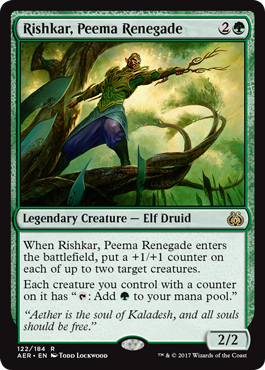
In addition to being a great addition to various +1/+1 counter decks, Rishkar is a strong commander that turns random value creatures into mana dorks. A list:
Rishkar, Peema Renegade
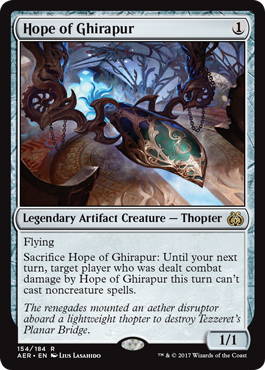
There are only a handful of ways to repeatedly recur this dude in monobrown, so I think you’re better off trying to figure out how to win with Commander damage than you are trying to Silence everyone for the rest of the game. Cheap, evasive bodies are exactly what Voltron decks are looking for, and no other colorless commander comes down as quickly as Hope.
The Maindeck Cards
In this set review, I’ll be using two five-point rating scales to evaluate the nonlegendary cards, one that measures how many decks a card is playable in (we’ll call that “spread”), and one that measures how powerful it is in those decks (”power”). Here’s a brief rundown of what each rank on the two scales means:
Spread
1: This card is effective in one or two decks, but no more (ex: The Gitrog Monster). 2: This card is effective in one deck archetype (ex: self-mill decks). 3: A lot of decks will be able to use this card effectively (ex: decks with graveyard interactions). 4: This card is effective in most decks in this color. 5: Every deck in this color is able to use this card effectively.
Power
1: This card is always going to be on the chopping block. 2: This card is unlikely to consistently perform well. 3: This card provides good utility but is not a powerhouse. 4: This card is good enough to push you ahead of your opponents. 5: This card has a huge impact on the game.

Spread: 4
Power: 2
Getting revolt and only being able to target tapped creatures are not insignificant restrictions, but White has basically zero ETB creatures that just straight-up kill stuff, so I’m willing to give her the benefit of the doubt. Note that she is Sun Titan- and Recruiter-compliant and that she’s a playable Dwarf for Depala.

Spread: 4
Power: 1
Using her fairly seems like a terrible idea, since she requires you to let somebody else kill you (which could obviously backfire horribly if anyone has a removal spell). She could be interesting if you’re trying to dig really deep with Necropotence or Hate someone to death, but Resolute Archangel seems like a safer bet (and you actually get to keep your angel).

Spread: 1
Power: 2
This one is a little speculative, since I’m not sure exactly what deck it fits into. However, White sources of card advantage are usually worth scrutinizing, and small bodies are relatively easy for White to recur.

Spread: 2
Power: 3
An auto-include in Jor Kadeen that I believe has potential in other White token builds. Three bodies for four is not a terrible rate, and when you factor in the mana generated by this card, you’re actually paying quite a bit less than that.

Spread: 5
Power: 3
The jump between 2 CMC counterspells and 3 CMC counterspells is a big deal, but so is the added flexibility of a Stifle. Any deck running a lot of counters is going to be happy to add this to its suite.

Spread: 1
Power: 1
This will work about 30% of the time when you play it in your Breya tribal Thopter list.
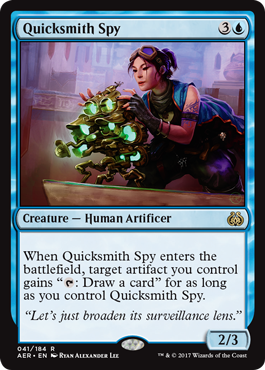
Spread: 1
Power: 3
This is actually pretty legit as a way to draw more cards in Paradox Engine combo decks. Not sure other decks will be able to get enough value out of it to justify its inclusion.
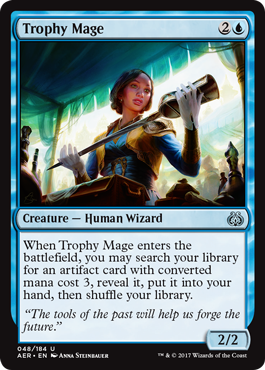
Spread: 2
Power: 2
I think that you probably shouldn’t run Trophy Mage if your game plan is to grab Worn Powerstone or Coalition Relic or something. If, however, you’re running combo pieces that happen to be CMC 3, the Mage will do good work.

Spread: 3
Power: 3
The initial testing I’ve done with this card has shown me that Improvise is significantly worse than Convoke since you’re not likely to be running a bunch of artifacts that don’t already tap for mana. While you could typically count on Chord of Calling costing 2ish mana less than what’s printed on the card, you should expect that Whir of Invention will not be discounted during most games (unless your deck has a bunch of artifact tokens for some reason). The card is somewhere between Transmute Artifact and Reshape in power level, and I don’t think it’s correct to run it unless you’ve got artifacts that will win you the game (whether by themselves or as part of a combo).

Spread: 1
Power: 1
This is not a Dark Confidant, and I don’t think the energy deck is a real thing in Commander. You should probably view this as a worse Pain Seer.
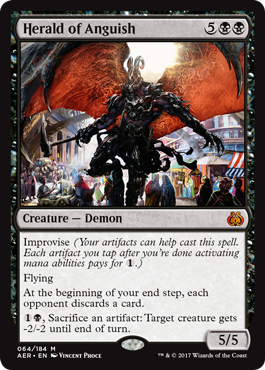
Spread: 2
Power: 2
Not really sure what deck this is for. Kaalia can do much more powerful things than trading Signets for Disfigures or taking a card from each opponent and I doubt the Black artifact decks are interested in a sac outlet that costs 7ish mana.

Spread: 2
Power: 3
If your metagame tends towards low mana curves with lots of mana dorks and small utility creatures, there’s a reasonable chance that this will be a 1-mana board wipe.

Spread: 1
Power: 3
I think this could be good in something like Purphoros, where you have a ton of tokens to feed to it and more creatures entering the battlefield on your side is exactly what you want to be doing.

Spread: 1
Power: 2
Some Zada decks run Fists of the Anvil, and this is strictly better.

Spread: 1
Power: 3
I think Kari Zev’s Expertise could be pretty sweet in a Zada deck. Giving all your dudes haste is marginal but casting a million cheap spells for free seems perfect for the deck, since Zada can have a little trouble generating enough mana while she’s going off.
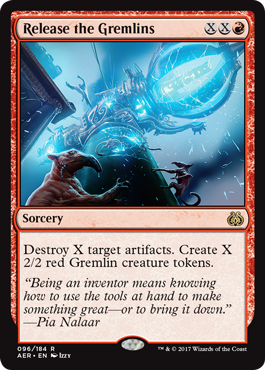
Spread: 4
Power: 2
I’d probably play this if it was colorshifted to White, but Red has a lot of strong competitors when it comes to artifact destruction (Vandalblast, Shattering Spree, Rack and Ruin, etc.). I think Purphoros might like it, since both halves of the card are useful in that deck, but most other lists can skip it.
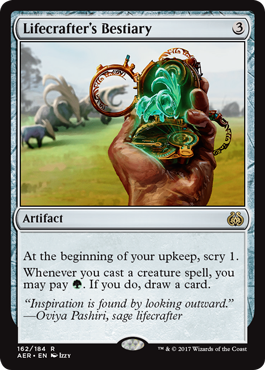
Spread: 2
Power: 3
This seems like a solid addition to any Elfball-ish deck that has a lot of mana and is always looking for gas. For example, that Rishkar list I posted earlier.
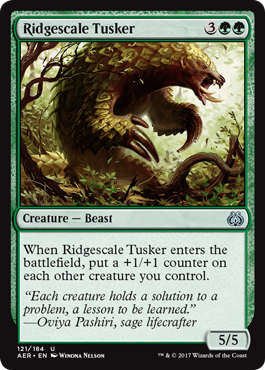
Spread: 2
Power: 2
I think this is a pretty reasonable card to play in +1/+1 counter aggro decks that just want to turn on their Oona’s Blackguard or get value off of their Hardened Scales.

Spread: 2
Power: 4
I’m actually a big fan of these kinds of cards in fatty-heavy Green builds that are looking for ways to restock their hands. Rishkar’s Expertise is only slightly more expensive than most of these effects, and it’s likely to refund most of that mana when it resolves.
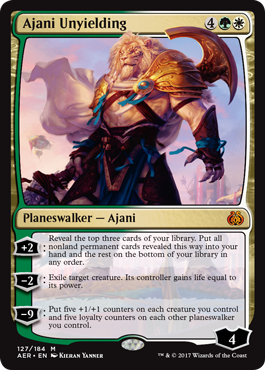
Spread: 4
Power: 2
Green/White decks to be permanent-based, so the +2 is pretty likely to hit and obviously the -2 is almost always going to be relevant. The main question is whether he’s worth six mana, and I believe the answer is no for most decks. The one deck where I think he could be above average is Planeswalker control. Generating card advantage and killing creatures are the most important abilities for a planeswalker to have in that deck, so Ajani should be right at home.

Spread: 5
Power:1
Seems super low impact compared to other cards in these colors. Compare with Capital Punishment.

Spread: 4
Power: 3
Cards that synergize with other good cards tend to be good themselves, and this guy is no exception. Green/White has a ton of spicy (and cheap) permanents that tend to draw removal, so there are always going to be solid targets for recursion. It’s also worth mentioning that he goes infinite with a sac outlet and Saffi Eriksdotter or Angelic Renewal. In fact, if you’ve got a Sterling Grove and a little time, you can sac Sterling Grove on your upkeep to put Greater Good on top of your library, draw it, then cast Rallier to reanimate the Grove. Sac the Grove again to put Angelic Renewal on top, then cast Greater Good and sacrifice any creature other than Rallier to draw the Renewal off the top. Cast Renewal, then Sacrifice Rallier to Greater Good, looting for three. Angelic Renewal returns Rallier, which returns Renewal. Repeat until you’ve dug through your entire deck for a win condition sac outlet.
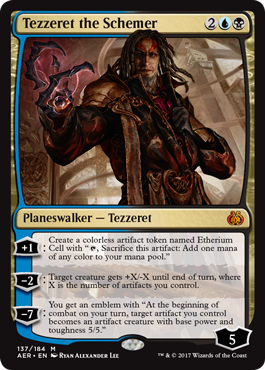
Spread: 2
Power: 2
While I do like the -2, the +1 is not impactful enough to make me want to use it and the ultimate is pretty terrible. Black has so many better options for removal that you don’t need to waste your time with this slow, expensive, narrow, situational card.
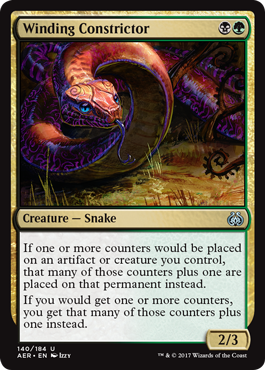
Spread: 2
Power: 3
It’s basically a second copy of Hardened Scales for the decks that want it. It’s a little worse against infect, but that’s whatever since the infect decks are already so lethal to begin with.

Spread: 1
Power: 1
Not only am I pretty confident that the energy deck doesn’t exist in Commander, but even if it did it would probably involve Blue, and I can’t imagine running this over one of Blue’s many Time Warp effects.
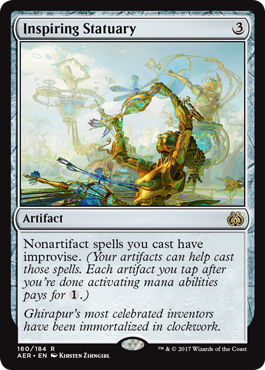
Spread: 1
Power: 2
The only lists I can think of that have enough non-mana rock artifacts and non-artifact spells to use this card tend to specialize in either artifact tokens, Vehicles, or Equipment. In artifact token or Vehicle decks, you’d almost always rather be attacking with your tokens/Vehicles. This might do something in the latter archetype.

Spread: 1
Power: 2
I don’t think this is good enough for most tribal decks, but it can generate free counters in Ghave.

Spread: 2
Power: 5
Best card in the set, and it’s not close.
Your deck has to be heavily invested in either mana rocks or mana dorks for this card to be effective, but if you’re in one of those camps then you’ll find it to be quite absurd. Once you have Paradox Engine and 3+ mana worth of rocks/dorks, you’ll find that every spell you cast is either free or it actually nets you mana, so you can just chain card draw spells and dig through your deck until you hit a win condition. It’s such a strong engine that it’s worth it to build an entire deck around tutoring it out, because the upside is enormous. This card will also change up the order in which Arcum Dagsson tutors for stuff, since it untap your Myr Turbine and your Arcum to net an additional tutor with every spell you cast.
Here’s a list built around Paradox Engine:
Nin Artifact Combo
Note that the deck doesn’t even have access to Black’s tutors, which means the ceiling on the Engine is even higher than the frequent T5 kills that list represents.
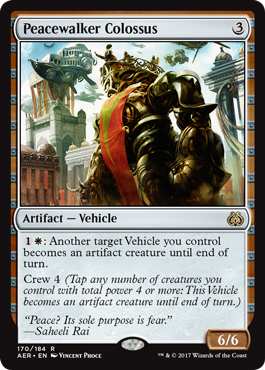
Spread: 1
Power: 2
Depala is the only deck so heavily invested in Vehicles that it could make use of this effect. I like the idea of limiting the amount of creatures you keep on the board in your Vehicle deck so that you can exploit Vehicle’s immunity to board wipes, and this card does a good job of enabling that strategy.
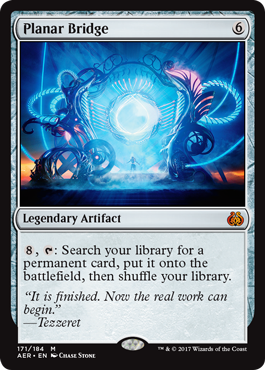
Spread: 2
Power: 2
Most colors have better ways of finding their win conditions, so I think it’s safe to say this is only likely to be good in Monored or Monobrown artifact ramp decks. It’s obviously absurdly expensive, but you’re probably going to be in a good position if you can fire it off even once, seeing as you can just grab a Blightsteel or an Eldrazi or something.
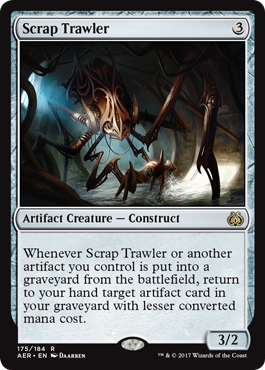
Spread: 2
Power: 3
This card is super hard to evaluate, so take those numbers with a grain of salt. It seems great in sacrifice-oriented artifact builds like Daretti or Breya, but I’m not quite sure how good it is if you’re playing an artifact deck that has less control over when things hit the graveyard.

Spread: 1
Power: 2
I’m always on the lookout for artifact creatures that generate value because I think artifact reanimation needs more solid targets to be truly good. Esper artifact decks probably have better things to do than try to cascade into value, but I think this guy could be playable in Daretti.

Spread: 1
Power: 2
If Mox Opal is good in your deck, I give you permission to run this card.
Wrapping Up
Please let me know if there are any cards you think I missed or if you think I evaluated any of these cards incorrectly. Thanks for reading!
122 notes
·
View notes
Text
How a Bunch of Letters Revolutionized My Classroom
New Post has been published on https://www.oneteacheraz.com/how-a-bunch-of-letters-revolutionized-my-classroom/
How a Bunch of Letters Revolutionized My Classroom
In my second year of teaching, I implemented something in my classroom that was an absolute game-changer. In my first year of teaching, I knew the kind of teacher I wanted to be and how critical building relationships with my students was to achieving that goal. But by my second year, I also knew how hard it was to quickly and authentically do so with 150 young people.
That year, my roommate was a more veteran teacher, and as she pored over dozens of letters from her own students one night, she shared her wisdom with me. Letter to the Teacher! In short, you require students to write you a letter once a week for a few weeks and then sporadically throughout the year. It could be a letter about themselves, asking you about yourself, or really writing to you about anything that’s school appropriate. If a student wants a reply from you, they must say “write back”, and then you respond via note to every student who wants a reply. It’s such a simple idea with countless benefits (and of course one major challenge–#notime!), but truly revolutionized my classroom and the gains I was able to make with my students due to the powerful relationships we built.
While building relationships is just one piece of the pie when creating a classroom climate in which students can excel, it’s an essential one. It doesn’t matter how good your “classroom management” is, without this piece, your class won’t provide all the opportunities it can for students (at best), and could be a place where no one—you included—wants to be (at worst). Letter to the Teacher is a great way to cultivate strong relationships with all your students and create the conditions in which incredible academic and personal growth can occur.
Below you’ll find the practical “how-to’s” and resources for implementing this in your secondary classroom, as well as the benefits of doing so. If you need more information, don’t hesitate to comment below or email me at [email protected].
The Roll-Out to Students
Build in time. Set aside 10 minutes of your class for students to write you a letter. I did Letter to the Teacher on Thursdays as our Do Now/Warm Up. You can find a sample PowerPoint slide introducing Letter to the Teacher here, but you may need to answer some questions before setting your students free to write. The first day was definitely more challenging because students felt awkward, had questions, didn’t know what to write, etc..
Set expectations. Letter to the Teacher should be a silent activity so students can focus on the “conversation” they’re having with you, and I told my middle- and high-schoolers that they should aim for about three-quarters of a page. Many didn’t write that much, but it set the expectation that a few sentences wasn’t going to cut it. While students work, you’ll likely need to circulate and help students who are struggling with ideas of what to write (“Tell me about yourself! Ask me about myself! Tell me about how school has been going for you so far! Etc.), but try to keep it pretty open ended because that’s when the magic happens. Make sure students know that you’ll read all the letters and write back to anyone who says “write back.”
Repeat. When I first started Letter to the Teacher each year, I did it once a week for about three weeks. I found that this was enough to establish it as a “thing” we did as well as allowed kids to get comfortable with it. I then went to once every two weeks-ish and then once a month or once every few months. Because of this, the time investment up front payed off without having to invest hours in letter writing for the rest of the year. Besides, after a few weeks of doing it, students were tired of writing to me and the lines of communication had been opened, so the letters weren’t quite as necessary.
The Back-End Logistics
Write back. The reason I typically did Letter to the Teacher on Thursdays was so I could devote some time to reading letters and writing back over the weekend. I bought one of those half-ledger notepads like this one and wrote my replies on that. I answered students’ questions, wrote them follow up questions, and generally tried to carry on the conversation they had started. I wrote kind of big and didn’t write nearly as much as they did, but each letter was personalized and addressed the things they wrote about.
Hand them back. First thing in class on Monday, I handed back the letters while students did their Do Now/Warm Up and allowed students to quickly read my responses while they were working. Doing this created some excitement around the letters and several students who hadn’t been so keen on the letter writing or hadn’t asked for a reply the first time were much more excited about engaging in the activity the second time around.
Be timely. Reading and responding to so many letters can definitely be a lot of work depending on how many students want responses from you, but 1) it’s amazing to see what students have on their minds when they’re candidly asked and 2) responding to letters is something you may be able to do while relaxing or watching TV, so while it’s work for school, it never felt like schoolwork to me. It’s so critical to hand back your responses in a timely manner because it’s an opportunity to deliver on a promise to students (the promise being that you’ll write back to them) and therefore build trust with them and because it shows that you value what they have to say—it’s not just another assignment, but that you truly care and want to get to know them.
Take notes. Because I don’t have the best memory and teaching can be chaotic at times, I used to write quick notes to myself as I was reading letters so I could follow up with students. For example, regardless of whether they wanted a written response, if someone told me they were playing a soccer game on Tuesday after school, I wrote myself a note (“5th period—Samuel—soccer, Tuesday”) so that I would remember to ask him about it on Wednesday. This went SUCH a long way in building relationships with students, both for them and for me. I became so much more invested in them the more I got to know them and the reverse was true as well, enabling us to all work harder towards a greater good.
The Upside
You can do the (next-to) impossible. Letter to the Teacher allows you to build relationships basically with all your students at once, which is next to impossible in secondary classrooms otherwise.
You can get to know your introverts, tricky students, and everyone else. Letter to the Teacher allows you to build authentic relationships in a different way, allowing you to reach more students. For me, it was always tricky to build relationship with my quieter, shyer students, but Letter to the Teacher allowed us space to get to know one another in a lower-stakes environment. This was true for the outgoing kids who weren’t going to come in just to chat, as well as the kids who often misbehaved in class and greatly benefited from a relationship with a teacher that wasn’t founded on them getting in trouble. In writing a letter, there’s not the pressure of a 1:1 conversation or group lunch (both of which I’m a fan of, too), and doing Letter to the Teacher over several weeks permitted kids to be more guarded in their letters at first and settle into the process on their own time if need-be. To this day, some of the best relationships I had with students were built on our early Letters to the Teacher.
It’s academic! While it has a clear culture-building purpose and you’re not checking for spelling and grammar, providing kids a structured opportunity to write builds their literacy skills.
It makes a statement. Incorporating Letter to the Teacher in your classroom makes a bold statement to your students about what you value and how much you care about getting to know them and allowing them to get to know you. Of course, a statement isn’t enough, you need to back it up with everything else you do and how you act, but if you’re devoting time to Letter to the Teacher, you’re likely going to.
It’s a two-way street. Letter to the Teacher allows students to get to know you not just vice versa. This is so critical if they’re going to trust you to lead them to the academic gains you plan to.
It’s the gift that keeps on giving. Especially in middle and high school, kids have “off” days. As these days come up throughout the year, Letter to the Teacher provides a constructive and reliable outlet for students to fall back on. I often had students come into class in a funk, and instead of acting out or disengaging completely, they’d ask to write me a letter. They were then able to re-engage positively in class, knowing not only that I could be a trusted source for them, but also that their issue would be heard and followed up on. While I was close to many students from my first year of teaching, it took so much longer to get to know them than it did to get to know students in subsequent years as a result of Letter to the Teacher. And on days when I knew a student was hurting but I had a classroom full of 30+ students to teach, I was so grateful for having a positive, constructive tool to use to connect with them individually when they needed me most.
It saves time in the long run. While implementing Letter to the Teacher is most definitely an investment in time (class time and personal time for you), you’ll save time and aggravation throughout the rest of the year on classroom management issues because you’ll have built one piece of a strong foundation in the first couple of months of school. For all students, but especially those in low-income schools, positive relationships with teachers are so, so critical for both behavioral and academic success.
The Downside
Time. While it’s not a time-consuming part of class, it is definitely a time commitment to read and reply to the letters. There’s really no way around that, as a large part of what makes this such an amazing activity is the dialogue it opens up between teachers and students. The time saving shortcut of just having students write you a letter without offering to respond to students who ask for it could send the message to students that their relationship with you is all about them being vulnerable and doing the work, rather than one in which you’re willing to give of yourself, too.
It’s sort of high-stakes. You have to follow through and deliver on your promise of responding to kids who want responses, and you have to do it in a timely fashion. It’s one thing to forget something academic (like that you were going to check the homework or look up the answer to a question), but it’s another to forget something personal. Both are bad, but if you’re trying to cultivate a strong culture, forgetting to follow through on a critical culture-building activity is one way not to do it. You also have to stick with Letter to the Teacher for a few weeks if you want everyone to reap the benefits of the time and energy you put into it. Kids may be shy at first, but sticking with it will allow them to open up to you and for you to truly dialog with them.
It’s only one piece of the pie. This isn’t a downside per se, but of course Letter to the Teacher is one (amazing!) tool to use when creating the strong classroom culture you want, but it’s not the only one. You need to have a strong classroom management system in place, as well as a plan for other ways to get to know your students and allow them to know you. Check back next month for even more relationship-building ideas, and if you’re struggling to figure out which classroom management system will work for you or how to implement your current system with fidelity, lean on your admin team, your colleagues or even some of your former teachers.
Nina Tinsley is the Director of Operations and Outreach at OneTeacher and a former secondary ELA and math teacher and classroom management and culture coach.
#Authentic#Classroom culture#Letter#Letter to the Teacher#relationships#resources#students#teacher#teaching
0 notes